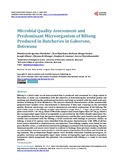Please use this identifier to cite or link to this item:
http://hdl.handle.net/10311/1280Full metadata record
| DC Field | Value | Language |
|---|---|---|
| dc.contributor.author | Matsheka, Maitshwarelo Ignatius | - |
| dc.contributor.author | Mpuchane, Sisai | - |
| dc.contributor.author | Gashe, Berhanu Abegaz | - |
| dc.contributor.author | Allotey, Joseph | - |
| dc.contributor.author | Khonga, Elenimo B. | - |
| dc.contributor.author | Coetzee, Stephan H. | - |
| dc.contributor.author | Murindamombe, Gervas | - |
| dc.date.accessioned | 2014-10-09T09:05:57Z | - |
| dc.date.available | 2014-10-09T09:05:57Z | - |
| dc.date.issued | 2014 | - |
| dc.identifier.citation | Matsheka, M.I., et al. (2014) Microbial quality assessment and predominant microorganism of biltong produced in butcheries in Gaborone, Botswana. Food and Nutrition Sciences, Vol. 5, No. 17, pp. 1668-1678 | en_US |
| dc.identifier.issn | 2157-944X (Print) | - |
| dc.identifier.issn | 2157-9458 (Online) | - |
| dc.identifier.uri | http://hdl.handle.net/10311/1280 | - |
| dc.description.abstract | Biltong is a dried ready to eat meat product that is produced and consumed to a large extent in Botswana. A study was undertaken with the objective of determining the microbial quality and isolating and identifying the predominant bacteria and fungi associated with the small scale production of biltong by local Butcheries. The physico-chemical characteristics of the commercially prepared beef samples were characterized to determine if they had a bearing on the microbial quality. Electron microscopy was used to characterize microbial colonization of the biltong. The total viable count of the biltong samples were found to range from 2 - 7 log10 cfu/g with a mean plate count of 8.9 × 105 cfu/g. About 42% of the samples had counts higher than 105 cfu/g, which is the recommended upper limit of acceptability as prescribed by the Public Health Laboratory Service guidelines. Bacteria from the genera Staphylococcus and Bacillus were found to be the predominant taxa associated with the biltong, a trend consistent with findings in previous studies on biltong. A total of 14 species were identified from the genus Staphylococcus with 20% of all bacterial strains identified as Staphylococcus saprophyticus. Four biltong samples were found to comprise Bacillus cereus, a well known food-borne pathogen associated with food poisoning. The predominant moulds and yeasts were found to conform to findings from previous studies conducted on intermediate moisture meat products with the genera Aspergillus, Penicillium and Candida being common. The predominant fungal species were Candida catenulate, Candida pararugosa, Aspergillus restrictus and Aspergillus niger. Some strains of Aspergillus niger are known to produce mycotoxins which compounds the potential risk associated with biltong as a ready to eat meat product. | en_US |
| dc.language.iso | en | en_US |
| dc.publisher | Scientific Research Publishing Inc. http://www.scirp.org/journal/fns/ | en_US |
| dc.subject | Biltong | en_US |
| dc.subject | Contamination | en_US |
| dc.subject | Molds | en_US |
| dc.subject | Aflatoxins | en_US |
| dc.subject | Water activity | en_US |
| dc.subject | Moisture content | en_US |
| dc.title | Microbial quality assessment and predominant microorganism of biltong produced in butcheries in Gaborone, Botswana | en_US |
| dc.type | Published Article | en_US |
| dc.link | http://www.scirp.org/journal/PaperInformation.aspx?PaperID=49523#.VDU_C2eSxmU | en_US |
| Appears in Collections: | Research articles (Dept of Biological Sciences) | |
Files in This Item:
| File | Description | Size | Format | |
|---|---|---|---|---|
| Coetzee_FNS_2014.pdf | 2.7 MB | Adobe PDF |  View/Open |
Items in DSpace are protected by copyright, with all rights reserved, unless otherwise indicated.
